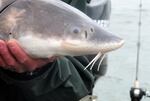
Sturgeon, the enormous Northwest fish, is now “catch-and-release” only on the lower Columbia. Biologists are still studying the causes of the sturgeon’s slow decline there.
Rob Manning / OPB
If you’re planning to hop in a boat this summer and pull a sturgeon out of the Columbia River -- you might not need that big icebox to bring one home.
That enormous Northwest fish is now “catch-and-release” only, on the lower Columbia. Biologists are still studying the causes of the sturgeon’s slow decline there.
That likely means many years of reeling big fish in, and tossing them back.
Professional fishing guide, Bob Rees, steers his boat out of the Oregon town of Hammond, near the mouth of the Columbia. He’s taking a boatful of customers into shallow water to hook sturgeon.
“If you drop off the ledge just in the shipping channel over here, it can get as deep as 57 foot. There’s this big sand tongue that comes down here -- Desdemona Sands -- and the fish come up on the shallower sands, and feed for bait fish and sand shrimp," Rees explains.
Rees says he knows at least 20 good spots to catch sturgeon out here. He checks to see where the fish are.
“You can see these black hashmarks on the screen here, are sturgeon down on the bottom of the river. Have you seen a sturgeon up close before? They’re pretty unique looking,” Rees says.
Sturgeon have long whiskers, distinctive ridges along their sides, and sucker-like mouths. They seem to live forever -- and they just keep growing. They can be a dozen feet long, hundreds of pounds, and they can live to be 100 years old.
They live in salt and freshwater. The species has been around since the dinosaur era.
But sturgeon have struggled in recent years. They were overfished in the 1900’s, but came back. Now they’re down again. Rees says the same sea lions that have eaten salmon in the Columbia have also chased sturgeon east to Bonneville Dam and south up the Willamette River.
“There’s a reason these fish have survived for 200 million years, they kind of know what they’re doing. We certainly don’t want to have our fingerprint on their decimation after 200 million years of success,” Rees says.
State officials also connect the recent decline in adult sturgeon numbers to sea lions... continue reading this story at OPB News where this report originally appeared.
